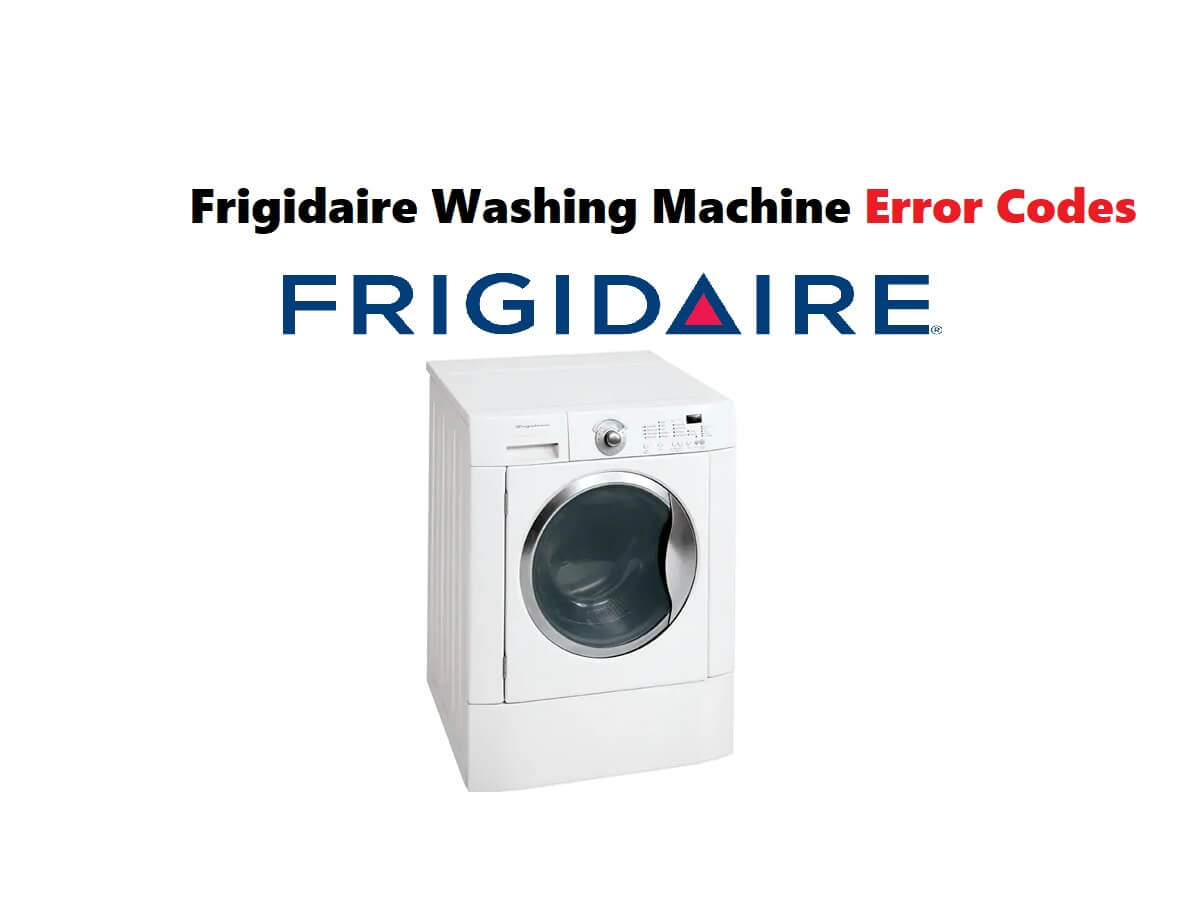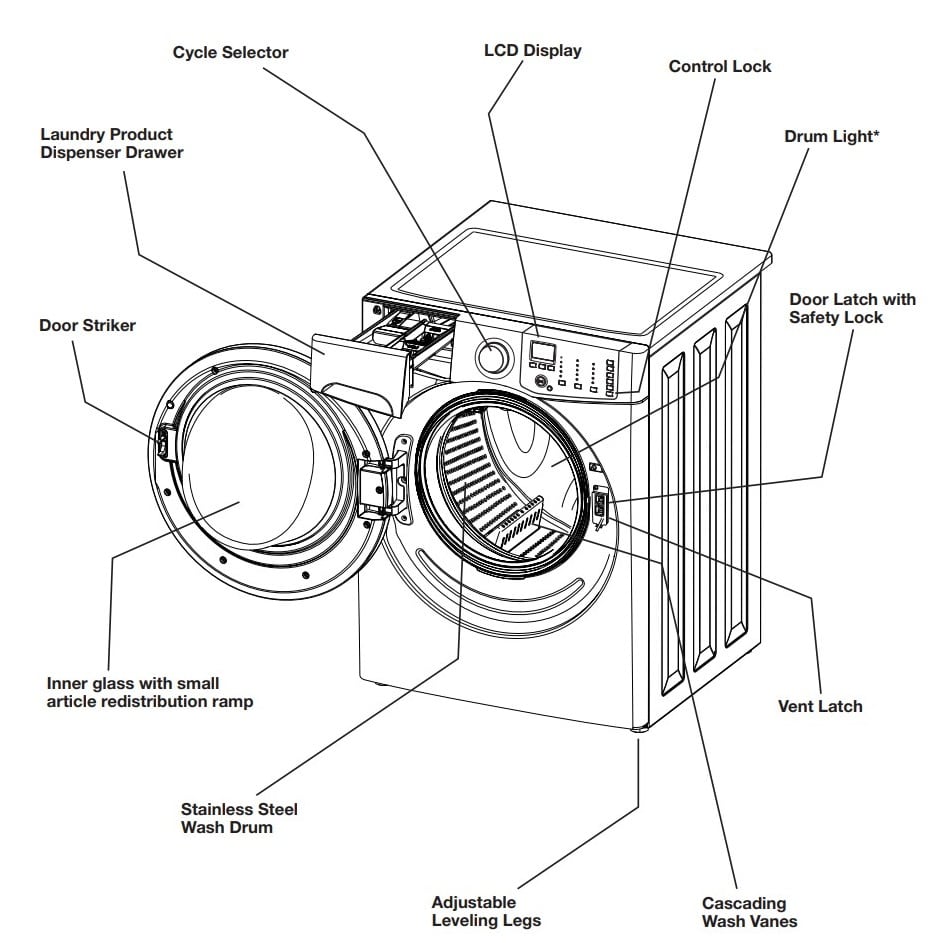
Frigidaire Washing Machine Error Codes
| Error Codes | Solution |
|---|---|
| E01 | The door of your machine is left open. Close the machine door. If your machine persists to indicate fault, turn off your machine, unplug it and contact the nearest authorised service immediately. |
| E02 | The water pressure or the water level inside the machine is low. Turn on the faucet. Mains water may be cut-off. If the problem still continues, your machine will stop after a while automatically. Unplug the machine, turn off your faucet and contact the nearest authorised service. |
| E03 | The pump is faulty or pump filter is clogged or electrical connection of the pump is faulty. Clean the pump filter. If the problem persists, contact the nearest authorised service. |
| E04 | Your machine has excessive amount of water. Your machine will discharge water by itself. Pursuant to discharging operation, turn off your machine and unplug it. Turn off your faucet and contact the nearest authorised service. |
| E11 | Fill time too long. |
| E13 | Water leak in the tub or air leak in the water level pressure sensor air hose. |
| E14 | Dispenser drawer not closed. |
| E21 | Drains slowly. |
| E23 | Drain pump relay failed. |
| E24 | Drain pump relay failed. |
| E31 | Water level pressure sensor isn't communicating with the electronic control board. |
| E35 | Water level pressure sensor detects overfill. |
| E43 | Control detects a problem with the door lock circuit. |
| E44 | Control board failure. |
| E45 | Control board failure. |
| E46 | Control board failure. |
| E47 | Control detects an open door lock circuit in spin mode. |
| E48 | Control detects a problem with the door lock circuit. |
| E52 | Bad signal from the drive motor tachometer. |
| E55 | Motor overheating. |
| E56 | High motor current. |
| E57 | High current on inverter. |
| E58 | High current on motor phase. |
| E59 | No tachometer signal for 3 seconds. |
| E5A | Motor control board is overheated. |
| E5B | Motor control board is overheated. |
| E5C | Motor control board is overheated. |
| E5D | Communication failure between the electronic control board and the motor control board. |
| E5E | Communication failure between the electronic control board and the motor control board. |
| E5F | Communication failure between the electronic control board and the motor control board. |
| E67 | Incorrect voltage supply to the microprocessor on the electronic control board. |
| E75 | Failed water temperature sensor circuit. |
| E95 | Electronic control board communication error. |
| EB1 | Incoming power frequency out of limits. |
| EB2 | Incoming line voltage is above 130 volts AC. |
| EB3 | Incoming line voltage is below 90 volts AC. |
| EF1 | Clogged drain pump. |
| EF2 | Too much suds. |
| EF5 | Better models only. NTC temperature for the cold water valve over the limits. Hot and cold water hoses switched. |

Cleaning Dispenser Drawer Area

- Remove the drawer by pulling the drawer out until it stops.
- Reach back into the left rear corner of the drawer cavity and press down fi rmly on the lock tab. Pull out the drawer.
- Remove the insert from the bleach and fabric softener compartments.
- Rinse the drawer and inserts with a combination of ¾ cup liquid chlorine bleach and 1 gallon hot tap water to remove traces of accumulated powders and liquids. Large amounts of fabric softener residue may indicate improper dilution or more frequent cleaning is required. Rinse well with tap water.
- To clean the drawer opening, use a small brush to clean the recess. Remove all residue from the upper and lower parts of the recess.
- Replace the insert by pressing it in place until you hear a slight click. Return the dispenser drawer.
Frigidaire Washing Machine Troubleshooting

Many washing problems involve poor soil and stain removal, residues of lint and scum, and fabric damage. For satisfactory washing results, follow these suggestions provided by The Soap and Detergent Association.
| Problem | Solutions |
|---|---|
| Blue stains | Undiluted liquid detergent or fabric softener dispensed directly onto fabric. |
| Discoloration, graying | 1. Rewash with correct amount of detergent and hottest water safe for fabric. 2. Add bleach safe for fabric. |
| Greasy, oily stains | 1. Treat with prewash stain remover or liquid detergent. 2. Increase detergent and water temperature. Rewash. 3. Rub fabric softener stains with bar soap. |
| Holes, tears, or snags | May be irreversible if rips, tears and seams cannot be mended. |
| Lint | 1. Reduce load size. Rewash using correct water temperature, water level, and amount of detergent. 2. Add nonprecipitating water conditioner to wash water to remove detergent residue. 3. Add liquid fabric softener to final rinse. 4. Dry load in dryer. 5. Remove lint with lint brush or roller. |
| Pilling (Fibers ball up and cling to fabric.) | Use a lint brush or shaver to remove pills. |
| Residue or powder on dark items; Stiff, harsh fabrics. | Rewash load. |
| Wrinkling | 1. Reduce load size. 2. Rinse in cold water with liquid fabric softener using the casual or delicate cycle. |
| Yellow buildup of body soil on synthetic fabrics | 1. Soak in detergent booster or product containing enzymes. 2. Wash in hottest water safe for fabric using casual cycle. 3. Increase detergent. 4. Add bleach safe for fabric or treat with color remover. |
| Yellow or brown rust stains | 1. To restore discolored load of whites, use rust remover safe for fabric. 2. Do not use chlorine bleach to remove rust stains. It may intensify discoloration. |
| Residue stains / buildup, mold or mildew stains in gasket | 1. Perform SYSTEM CLEAN cycle 2. Scrub gasket with Comet Spray Gel Mildew Stain Remover using brush to remove stains. 3. Use only HE (high effi ciency detergent) along with recommended dosage. 4. Remove wash load immediately upon cycle completion. |
| Water in fold of flexible gasket | At the end of each wash, dry inside of gasket fold with clean dry towel all around gasket |
| High pitch “jet engine” noise. | A certain amount of motor whine is normal during the spin cycle. |
| Thumping sound. | Heavy wash loads may produce a thumping sound. This is usually normal. If sound continues, washer is probably out of balance. Stop washer and redistribute wash load. |
| Washer won’t spin. | Load is too small. Add 1 or 2 similar items to help balance the load. |
| Residue left in drum. | Heavily soiled items. Wipe drum with a nonabrasive household cleanser, then rinse. Shake or brush excess dirt and sand from items before washing. |
| Water collects in folds of the bellows at the end of the cycle. | This is a result of the washing action and is part of the normal operation of the washer. |
| Water collects in bleach and fabric softener compartments. | This is a result of the siphoning action and is part of the normal operation of the washer. Water may be removed by removing the dispenser drawer (see Care and Cleaning in this guide) and draining water into the empty drum or sink. |
| Water leaks. | Fill hose connection is loose at faucet or washer. Check and tighten hose connections. Install rubber sealing washers provided. |
| Incorrect wash and rinse temperatures. | Hot and cold water hoses are connected to wrong supply faucets. Connect hot water hose to hot water faucet and cold water hose to cold water faucet. |